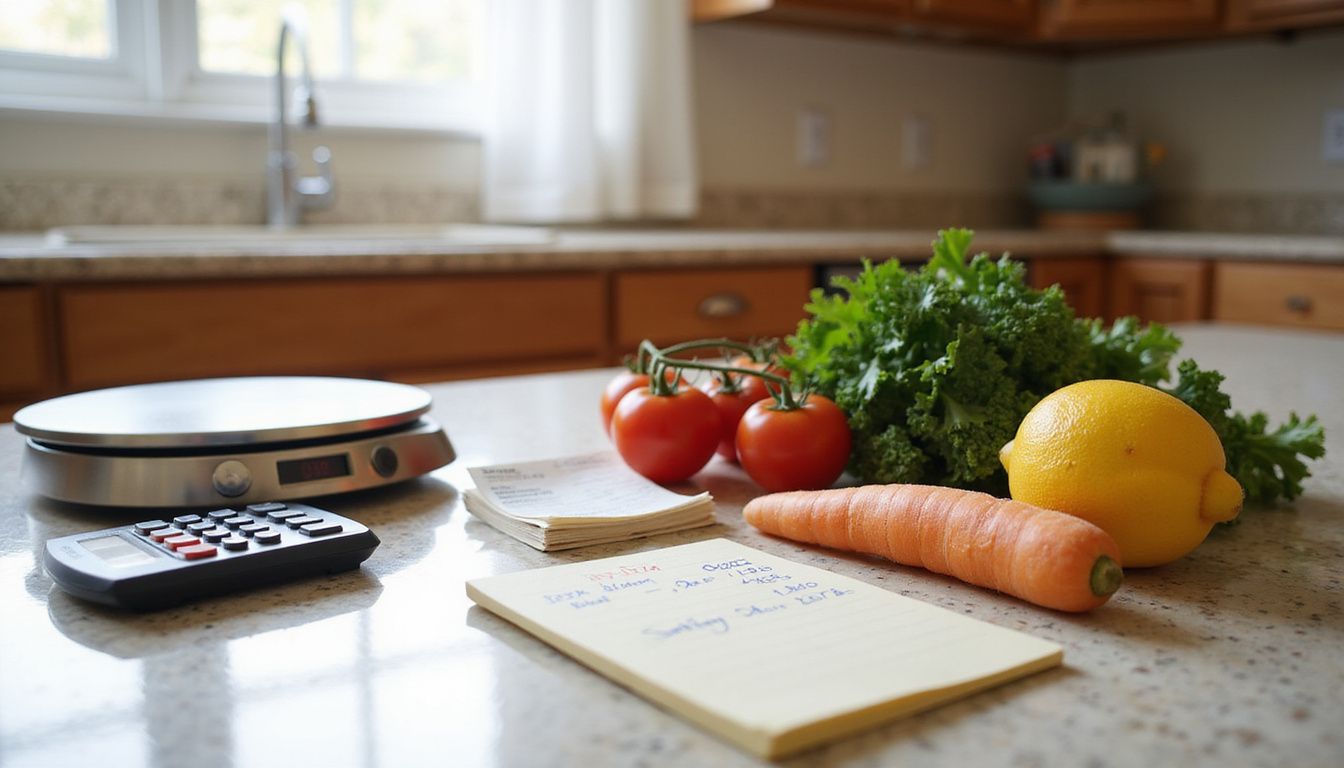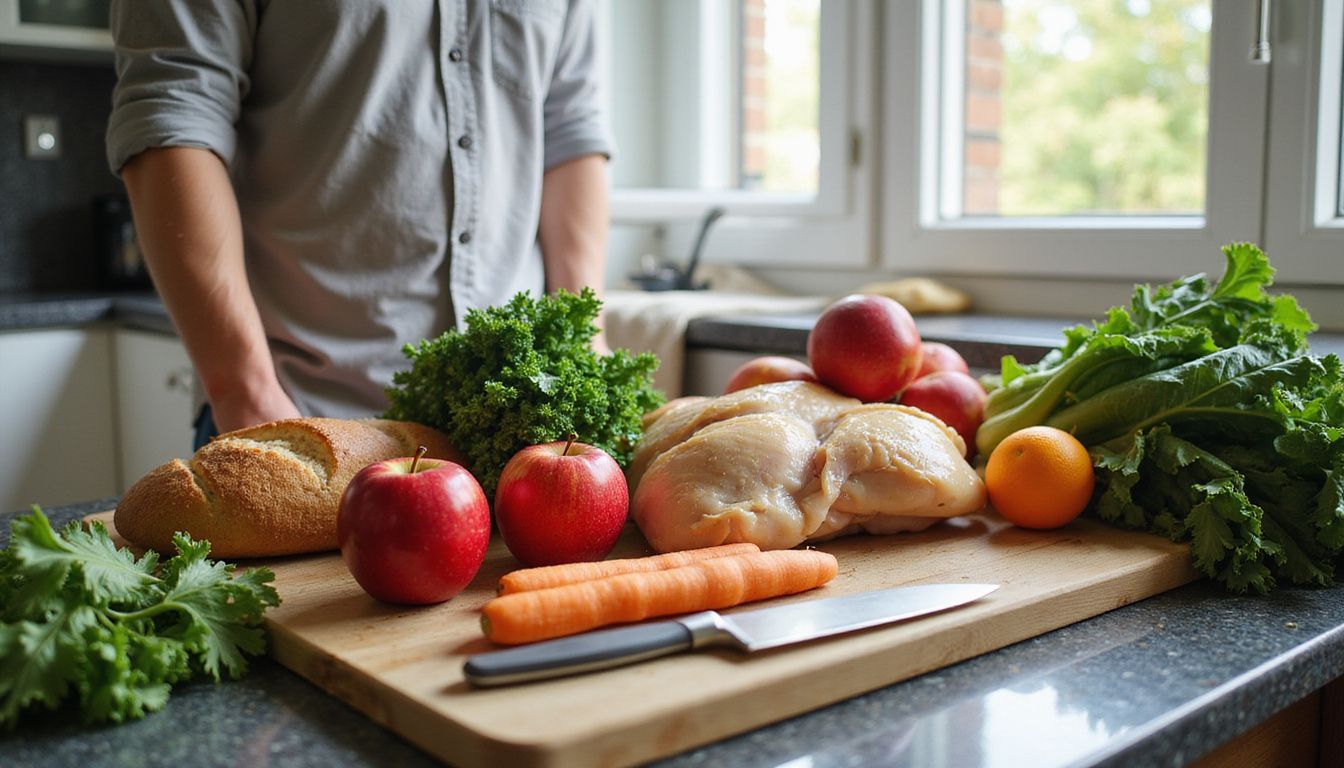Calorie Count: The Ultimate Guide To Calculating Your Calorie Intake
Our Nutrition Assistant AI Suite will transform your body. You will lose fat, get toned, and build muscle. Gain confidence and optimal health.
Figuring out how many calories to eat can feel confusing. A simple calorie calculator and a few clear steps make it easier to match your daily calorie intake to your goals.
This guide shows how calorie counting works, how to estimate your calorie needs, and how to use tools that keep you on track. With the right plan, you support steady weight loss, maintenance, or healthy weight gain.
Key Takeaways
- Estimate calorie needs with equations such as Mifflin-St Jeor or Harris-Benedict. Start with BMR, then apply an activity multiplier from 1.2, sedentary, to about 1.95, very active.
- To lose 1 pound a week, create a 500 calorie per day deficit from your Total Daily Energy Expenditure, TDEE. That equals a weekly deficit of about 3,500 calories.
- Balanced ranges: 45 to 65 percent of calories from carbohydrates, 10 to 35 percent from protein, and 20 to 35 percent from fat.
- Tracking with apps like MyFitnessPal or Lose It, wearables, and food labels improves accuracy and supports sustainable goals.
- High-calorie items include pizza and cheeseburgers, near 285 calories each. Low-calorie produce like lettuce has about 5 calories per cup. Sauces, dressings, and sweet drinks often hide extra calories.

What is Calorie Counting?

Calorie counting means tracking the energy you eat and drink each day. It helps you make a plan to reach a healthy weight and hit your calorie target.
What are calories?
Calories are units of energy. Your body uses them for every task, from breathing to running. Food provides calories from macronutrients, which are carbohydrate, protein, and fat. Carbs and protein have about 4 calories per gram, fat has about 9, and alcohol has 7. Fiber is a carb that your body absorbs less, often closer to 2 calories per gram.
Labels list estimated energy, but your body may absorb fewer or more calories based on digestion, cooking method, and how much you chew. Harder-to-digest foods raise the energy cost of digestion, called the thermic effect of food. About 3,500 calories equal a pound of stored body weight, which helps when planning weight loss or muscle gain.
Nutrient quality matters just as much as quantity when choosing foods within your calorie target.
Why is calorie counting important for nutrition and weight management?
Tracking calories helps you compare what you eat to what your body needs to maintain your current weight. If intake stays above needs, weight tends to rise. If intake drops below needs, or if activity increases, weight loss becomes more likely. Harvard Health and the Dietary Guidelines for Americans both support this energy balance approach.
Many people target a 500 calorie daily deficit to lose about 1 pound per week. Counting also highlights sources of empty calories, like sugary drinks, which crowd out nutrient-dense foods. Over time, this improves portion sizes, food choices, and awareness. Poor diets raise the risk of heart disease, type 2 diabetes, and some cancers. Careful tracking turns goals into daily actions you can measure.
How to Calculate Your Calorie Needs
Start with your daily energy use. Then match your eating plan to your goal weight. A short calculation gives you a clear daily target.
What is Basal Metabolic Rate (BMR)?
Basal Metabolic Rate, BMR, is the energy your body needs at rest for basic life functions. It covers your heart, lungs, brain, and organ activity when you are not moving. BMR does not include walking or Exercise.
Age, sex, height, weight, and muscle mass all affect BMR. More skeletal muscle usually means a higher BMR because muscle tissue uses more energy than adipose tissue. You can estimate BMR with equations such as Mifflin-St Jeor or Revised Harris-Benedict.
Example: A 30-year-old woman, 5 ft 4 in and 150 lb, often calculates a BMR near 1,400 calories per day. Health professionals use BMR first, then adjust for activity to set your total calorie needs.
BMR forms the foundation of any healthy diet plan because it helps estimate the number of calories you need to maintain your current human body weight.
Next, apply your lifestyle activity to move from BMR to TDEE.
How do you calculate Total Daily Energy Expenditure (TDEE)?
Total Daily Energy Expenditure, TDEE, is the total calories you burn in a day. It includes rest, daily movement, and structured workouts.
- Estimate BMR using Mifflin-St Jeor or Harris-Benedict with your age, sex, weight, and height.
- Select an activity multiplier that matches your lifestyle: Sedentary 1.2, Light 1.375, Moderate 1.55, Active 1.725, Very Active 1.9, Extra Active up to 1.95.
- Multiply BMR by the chosen activity factor to get TDEE.
- Use a trusted online calorie calculator for a quick check. Many include BMI and let you adjust for muscle mass.
- Update the multiplier if your routine changes, like moving from moderately active to active.
- Adjust calories based on goals. Eat fewer calories for weight loss, hold steady for maintenance, or eat more to gain weight.
- Higher muscle mass raises TDEE since muscle is more energy hungry than fat tissue.
- Tracking TDEE clarifies how dieting, hunger, and low-calorie plans might change your weight and energy levels.
- See a nutritionist if you have medical concerns or plan a very-low-calorie diet. This helps avoid risks such as refeeding syndrome.
How should you adjust calorie intake for weight loss, maintenance, or gain?
After you estimate TDEE, set your intake to match your goal. Keep it steady for a few weeks, then adjust based on progress.
- To lose about 1 pound per week, aim for a 500 calorie daily deficit from your TDEE.
- Some people use up to a 1,000 calorie daily deficit for faster loss. Do not go too low, since extreme cuts can harm metabolism and energy.
- Safe, sustainable loss is up to 2 pounds per week. Faster loss raises the chance of muscle loss.
- To maintain your current weight, eat close to your TDEE. Make small changes if weight shifts.
- For weight gain, add 250 to 500 calories per day for gradual progress.
- Track weekly using a scale or body measurements. Adjust if results do not match your plan.
- Calorie cycling, or zigzagging higher and lower days, may reduce plateaus.
- Use nutrition facts labels and calorie counting apps to tighten accuracy.
- Build balanced meals with enough protein, fiber, vitamins, and minerals to keep energy stable.
- Drink enough water each day since hydration supports digestion and metabolism.
- Consult a registered dietitian if you have conditions like diabetes or unique needs due to age or training.
Formulas for Calculating Calorie Needs
Several equations can estimate your BMR. These tools give a strong starting point for counting calories and setting your daily calorie target.
BMR formula for men
The Mifflin-St Jeor equation is widely used today. Use metric units.
Mifflin-St Jeor: BMR = 10W + 6.25H − 5A + 5. W is weight in kilograms, H is height in centimeters, and A is age in years. Example: 80 kg, 180 cm, 30 years gives a BMR near 1,790 calories.
Revised Harris-Benedict: BMR = 13.397W + 4.799H − 5.677A + 88.362. Katch-McArdle, best if you know body fat percent, uses lean mass: BMR = 370 + 21.6 × LBM, where LBM is lean body mass in kilograms.
Summary of common men’s BMR equations:
| Formula Name | Equation | Main Use |
|---|---|---|
| Mifflin-St Jeor | BMR = 10W + 6.25H − 5A + 5 | Most common modern method |
| Revised Harris-Benedict | BMR = 13.397W + 4.799H − 5.677A + 88.362 | Alternative classic method |
| Katch-McArdle | BMR = 370 + 21.6 × LBM | For known body fat percentage |
Use these numbers to set targets before applying activity multipliers to reach TDEE for daily planning.
BMR formula for women
For women, Mifflin-St Jeor is also a strong choice: BMR = 10W + 6.25H − 5A − 161. Again, W is kilograms, H is centimeters, and A is years.
Revised Harris-Benedict: BMR = 9.247W + 3.098H − 4.330A + 447.593. Katch-McArdle fits if you know body fat percent: BMR = 370 + 21.6 × LBM. Many women have lower BMRs than men due to lower average muscle mass, so accurate inputs matter.
Activity level multipliers
After calculating BMR, apply an activity multiplier to estimate TDEE. Choose the option that reflects your full day, not just workouts.
| Activity Level | Multiplier | Description | Example |
|---|---|---|---|
| Sedentary | 1.2 | Little or no exercise during the week | Desk job, minimal movement |
| Light Activity | 1.375 | Exercise 1 to 3 times per week | Office work plus light walking or light gym sessions |
| Moderate Activity | 1.55 | Exercise 4 to 5 times per week | Teacher, retail worker, or frequent moderate exercise |
| Active | 1.725 | Intense exercise 3 to 4 times per week | Construction work, regular high-intensity intervals |
| Very Active | 1.9 | Intense exercise 6 to 7 times per week | Manual laborer, athlete training daily |
| Extra Active | Up to 1.95 | Very intense training or highly physical job | Professional athletes, military training |
- Select the level that matches your whole lifestyle.
- Accurate TDEE supports smart planning for weight loss, maintenance, or gain.
- The activity choice is a key step in reliable calorie counting.
Tools for Tracking Calorie Intake
Good tools make counting easier and more accurate. Apps, food labels, and wearables work together to show intake and burn in one place.
What are the best calorie counting apps and online calculators?
A strong calorie counter saves time and reduces guesswork. Look for quick logging, barcode scanning, and clear nutrition insights.
- MyFitnessPal scans barcodes and tracks thousands of foods. Enter age, height, weight, and sex to set a daily goal.
- Lose It offers fast logging with a simple interface. You can scan or enter foods using USDA nutrition data.
- MyNetDiary displays detailed charts, adjusts targets with activity changes, and tracks macronutrients.
- Mayo Clinic’s calculator estimates BMR with Harris-Benedict. Enter personal details for a starting point.
- Many tools round goals to the nearest 50 calories to simplify planning.
- Most apps track macros, which shows how protein, carbs, and fat fit into your plan.
- Barcode scanning reduces logging errors with packaged foods.
- Wearables like Fitbit sync with apps to update TDEE based on Exercise and steps.
- Online calculators often link to USDA databases for current food data.
- After months of app use, I found my portions naturally shrank as awareness grew.
How do you use food labels to calculate calories?
Food labels give you serving sizes and calories per serving. Reading them closely helps you hit your daily calorie target.
- Check serving size first. All values on the label refer to that amount. Adjust if you eat more or less.
- Find the Calories line. Compare it to your daily goal to control portions.
- Carbs and protein have 4 calories per gram, fat has 9. Use these to estimate meals made from scratch.
- Watch for added sugars and solid fats. These add calories without many nutrients.
- Consider fiber and sugar alcohols. Some are not fully absorbed, which can lower net calories.
- Treat labels as estimates. Rounding and variation can shift totals up or down.
- Compare similar products to choose lower-calorie or more nutritious options.
- Match your actual portion to the listed serving. This is where many errors start.
- After a few weeks, patterns appear, like certain snacks that push you over your limit.
- Using labels helped me spot high-sugar items and cut extra snacking.
How do wearable devices help with calorie tracking?
Wearables estimate calories burned using heart rate, steps, and activity type. Many also estimate your resting metabolic rate based on your stats.
These devices sync with apps to show intake versus output in real time. You can raise or lower your calories after a workout instead of guessing. Last summer, using a tracker while cutting weight, I stayed motivated by watching my daily burn rise with even short walks.
Since wearables collect data all day, they often improve accuracy over manual estimates. Seeing trends helps you stay accountable and make steady progress.
Calories in Common Foods
Knowing the calorie cost of everyday foods prevents surprises. Small portions of rich foods can add up fast.
Which foods are high in calories?
Some foods pack a lot of energy into small amounts. Keep an eye on portions to stay within your calorie goals.
- Pizza has about 285 calories per slice from a large pie. Extra cheese or meats can increase this.
- Cheeseburgers average around 285 calories each, before sides and sauces.
- Butter has 102 calories in one tablespoon. Spreads and sautés add up quickly.
- Caesar salad can reach about 481 calories in 3 cups due to dressing, cheese, and croutons.
- Rice provides about 206 calories per cup. Large servings drive totals higher.
- Beer has about 154 calories per 12 ounces. Multiple drinks raise daily intake fast.
- Dark chocolate is about 155 calories per ounce. A few squares can turn into a meal’s worth.
- Whole milk has about 146 calories per cup. Full-fat dairy raises totals quickly.
Processed and fried foods, and items rich in oils or sugar, are often the densest. Two small extras can equal a meal.
Which foods are low in calories?
Low-calorie foods let you eat larger portions while keeping intake modest. They also add fiber and water, which help you feel full.
- Lettuce, about 5 calories per cup. Build volume in salads and wraps.
- Cucumber, about 17 calories per 4 ounces. Snack with hummus or add to salads.
- Tomato, about 22 calories per cup. Adds flavor to bowls and sandwiches.
- Asparagus, about 27 calories per cup. Roast or steam for a quick side.
- Eggplant, about 35 calories per cup. Grill, bake, or sauté for hearty texture.
- Broccoli, about 45 calories per cup. Steam or stir-fry for a fiber boost.
- Watermelon, about 50 calories per cup. Hydrating and sweet.
- Strawberry, about 53 calories per cup. Top yogurt or cereal.
Filling your plate with produce helps manage hunger and total daily calories.
What are surprising sources of hidden calories?
Many items seem light but pack extra calories through sugar or fat. These can stall progress if you are not watching portions.
- Flavored yogurt often includes added sugar. One cup of low-fat flavored yogurt has about 154 calories, while non-fat plain has near 110.
- Salad dressings and toppings can turn a salad heavy. A 3-cup Caesar can reach 481 calories.
- Sweet coffee drinks add syrups and cream. Plain coffee is low-calorie, but add-ins change that fast.
- Regular soda has about 150 calories per can. Diet versions have zero, which shows the sugar impact.
- Reduced-fat products sometimes add sugar to improve taste, raising calories without extra nutrition.
- Fruit juices are concentrated sugar. One cup of orange juice has about 111 calories, apple cider about 117.
- Convenience items like a 6-inch turkey sub can start around 200 calories before cheese and sauces.
During one week of logging, I found sauces and dressings added hundreds of extra calories. Scanning labels and measuring portions protects your plan.
The Role of Macronutrients in Calorie Counting
Macronutrients are the main energy sources in food. Carbs, protein, and fat each support your body in different ways.
How many calories come from carbohydrates?
Carbohydrates provide about 4 calories per gram. A slice of bread, 1 ounce, delivers around 70 to 80 calories, mostly from carbs. A cup of cooked rice has about 206 calories, largely carbs.
A medium apple delivers mostly carbohydrate calories. Corn and carrots do as well. Guidelines suggest 45 to 65 percent of daily calories from carbohydrates. Fiber, a type of carb, gives fewer calories because it is not fully absorbed. The thermic effect of food means digestion also burns some energy.
How many calories come from proteins?
Protein provides about 4 calories per gram and helps build and repair muscle. Many people do well with 10 to 35 percent of calories from protein.
Protein foods include beef, chicken, eggs, fish, shrimp, and tofu. Two ounces of cooked beef is around 142 calories, chicken about 136, and shrimp about 56. A large egg has about 78 calories. Four ounces of tofu are about 86 calories. Adequate protein supports fullness and protects muscle during weight loss.
How many calories come from fats?
Fat provides about 9 calories per gram, which is more than carbs or protein. One tablespoon of butter has about 102 calories because it is mostly fat. A cup of whole milk has about 146 calories from a mix of fat, carbs, and protein.
Guidelines often suggest 20 to 35 percent of daily calories from fat. Oils, fried foods, nuts, and many snacks carry high fat calories. Foods that combine fat and carbs, such as pastries or pizza, are easy to overeat. Tracking fat helped me spot hidden calories in dressings and spreads and cut daily totals without losing flavor.
Sample Calorie Plans
These examples show how to distribute calories across meals. Adjust portions to your needs and activity level.
What does a 2000-calorie meal plan look like?
A 2000-calorie day works for many adults who want to maintain weight. Aim for a balanced mix of carbs, protein, and fat.
- Breakfast, about 650 calories. Oatmeal with skim milk and fruit, plus eggs or lean ham.
- Lunch, about 685 calories. Grilled chicken, brown rice, mixed greens, and fruit.
- Dinner, about 665 calories. Fish or tofu, quinoa, steamed broccoli, and whole-wheat bread.
- Choose snacks that fit the total, like fruit, low-fat yogurt, or a small handful of nuts.
- Use every food group across the day to cover nutrients.
- Use labels and apps like MyFitnessPal to check packaged foods.
- Drink water or unsweetened drinks to stay hydrated without extra calories.
- Limit added sugars and saturated fat. Reach for nutrient-dense choices first.
- Measure portions with cups or a food scale for accuracy.
- Splitting calories across three meals plus a snack kept my energy steady and curbed late-night eating.
- This plan fits within common adult ranges of 2,000 to 3,000 calories, based on activity.
What does a 1500-calorie meal plan look like?
A 1500-calorie plan often supports weight loss for many adults. Focus on lean protein, vegetables, whole grains, and smart portions.
- Breakfast, about 350 calories. Scrambled eggs with spinach, whole-grain toast, and a small fruit.
- Lunch, about 550 calories. Grilled chicken breast, roasted sweet potato, and a mixed salad with vinaigrette.
- Dinner, about 600 calories. Baked fish or tofu, steamed vegetables, and brown rice.
- Include all major food groups to maintain balance and satiety.
- Use smaller plates and measured servings to manage portions.
- Add a light snack if needed, such as carrot sticks or low-fat yogurt.
- Pair the plan with regular physical activity for better results.
What does a 1200-calorie meal plan look like?
A 1200-calorie plan is quite low. It can fit small, less active adults for short periods, though medical guidance is wise for safety.
- Breakfast, about 345 calories. Scrambled eggs with spinach, a slice of whole-grain toast, and fresh berries.
- Lunch, about 450 calories. Grilled chicken with mixed vegetables and quinoa.
- Dinner, about 405 calories. Vegetable soup with tofu or fish and a side of brown rice.
- Every meal should be nutrient-dense since there is little room for extras.
- Lean proteins, vegetables, and whole grains support fullness and nutrition.
- Avoid high-calorie processed items and sugary drinks, which crowd out nutrients.
- This level may be too low for highly active people or those with more muscle.
- Many guidelines cite 1200 calories as a lower limit for women without close monitoring.
- Track vitamins and minerals closely to avoid shortfalls.
- Consult a registered dietitian for longer use or if you have health conditions.
- Use this plan for short-term goals under professional oversight.
Understanding Calories Burned During Exercise
Exercise changes the math. Knowing what you burn helps you adjust daily calories with confidence.
How many calories do common exercises burn?
Calorie burn depends on your weight, intensity, and time. These estimates show typical ranges for one hour of activity.
- Running at a nine-minute mile: about 624 calories at 125 lb, 773 at 155 lb, 923 at 185 lb.
- Swimming, moderate pace: about 397 at 125 lb, 492 at 155 lb, 587 at 185 lb.
- Cycling, 12 to 14 mph: about 454 at 125 lb, 562 at 155 lb, 671 at 185 lb.
- Basketball: about 340 at 125 lb, 422 at 155 lb, 503 at 185 lb.
- Soccer: about 397 at 125 lb, 492 at 155 lb, 587 at 185 lb.
- Golf with a cart: about 198 at 125 lb, 246 at 155 lb, 294 at 185 lb.
- Kayaking: about 283 at 125 lb, 352 at 155 lb, 420 at 185 lb.
- Tennis: about 397 at 125 lb, 492 at 155 lb, 587 at 185 lb.
- My wearable showed tennis sessions burned more than I expected, which kept me consistent.
How do intensity and duration affect calorie burn?
Higher intensity burns more calories each minute. Vigorous activities like running or soccer can burn 400 to over 900 calories per hour depending on weight. Moderate Exercise done four to five times weekly often aligns with a 1.55 activity multiplier. Very strenuous daily routines can reach up to 1.95.
Longer sessions raise total burn even at moderate pace. A 60-minute brisk walk usually burns more than a short sprint session. Sedentary days use a 1.2 multiplier. Extending a workout by 15 minutes made a visible difference in my weekly numbers compared with shorter, equal-intensity sessions.
Summary table
| Activity Level | Example | Multiplier | Calories Burned per Hour* |
|---|---|---|---|
| Sedentary | Minimal movement | 1.2 | ~70 to 90 |
| Moderate, 4 to 5x per week | Brisk walking, cycling | 1.55 | ~250 to 500 |
| Vigorous | Running, soccer | Up to 1.95 | ~400 to 900+ |
*Depends on body weight and exact activity.
Advanced Tips for Effective Calorie Management
Once the basics are set, small tactics help you keep progress moving.
What is zigzag calorie cycling?
Zigzag calorie cycling alternates higher and lower calorie days while keeping weekly totals on target. For example, eat 2,300 calories for three days and 1,775 for four days to reach 14,000 weekly calories.
Many people vary 200 to 300 calories between days. Higher days often sit near maintenance to fuel hard workouts and protect muscle. There is no fixed split. Choose what fits your schedule. Tracking daily totals in an app made this method easier for me to follow over time.
How do you track portion sizes effectively?
Portion control improves accuracy more than any other habit. A few simple tools make a big difference.
- Use a digital food scale to weigh items before eating.
- Measure with cups and spoons for oils and nut butters.
- Compare your portions to label serving sizes.
- Use smaller plates to reduce portions. Research suggests plates can influence intake by about 20 percent.
- Use visual cues. A palm equals a typical meat serving. A fist equals about a cup of rice.
- Track intake in an app or simple spreadsheet.
- Weigh in at the same time weekly to check trends.
- Review your records and adjust portions where needed.
Why is hydration important for calorie management?
Water, tea, and black coffee are low or zero calorie. High-calorie drinks like soda and sweet juices can raise daily intake quickly. Many people get about one fifth of their calories from beverages.
Hydration may help control appetite. The body sometimes confuses thirst with hunger. Drinking a glass of water before a meal can help you feel full and reduce overeating. One simple swap, changing sweetened coffee to black coffee, cut more than 150 calories from my day.
Myths and Facts About Calories
Misconceptions can derail a plan. Clearing them up leads to better choices and less frustration.
Are all calories created equal?
Calories vary in how they affect hunger, energy, and health. Chewing and digesting whole foods uses more energy than processed snacks, which raises the thermic effect slightly. Whole foods also carry fiber, vitamins, and minerals.
Fat has 9 calories per gram. Carbs and protein have 4 per gram. Energy density and nutrient density both matter. A 500 calorie plate of vegetables, lean protein, and whole grains fills you more than 500 calories of candy.
What are common calorie misconceptions?
These common ideas can mislead healthy eating:
- All calories act the same. In fact, macros influence hunger and metabolism differently.
- High-calorie foods always satisfy more. Protein and fiber often fill you better with fewer calories.
- Labels show exactly what you absorb. Digestion and cooking methods affect absorption.
- Weight loss is steady. The body adapts to deficits, which can slow results.
- Sauces and dressings are trivial. They often add hundreds of extra calories.
- Chewing does not matter. Foods that require more chewing can raise the thermic effect slightly.
- Age and muscle mass do not change needs. Both alter metabolism and daily calorie needs.
- Only quantity matters. Quality and nutrient density also drive results.
- Apps are perfect. My logs were off by about 10 to 15 percent when I rushed portions.
Important Considerations for Calorie Counting
Your needs are personal. Age, muscle, genetics, and activity all shape daily targets.
How do age, muscle mass, and metabolism affect calorie needs?
These factors drive how many calories you need:
- Younger people often need more calories than older adults due to higher BMR and activity.
- More muscle increases calorie burn at rest.
- BMR tends to decline with age, so daily needs can fall.
- BMR equations like Mifflin-St Jeor or Harris-Benedict give a starting point.
- Activity level amplifies these effects when you calculate TDEE.
- Metabolism varies between people and shifts with muscle changes and aging.
- Personalized guidance is best for kids, teens, older adults, or those with big muscle changes.
- An adult male athlete might need near 3,000 calories per day. A sedentary older adult might need near 1,600.
- A registered dietitian can tailor targets based on your body composition and routine.
When should you consult a registered dietitian for personalized advice?
See a registered dietitian if you have diabetes, heart disease, food allergies, or complex goals. They use equations like Harris-Benedict along with your gender, weight, height, age, and activity to set daily calorie targets.
Dietitians also teach portion skills and mindful eating. After a sports injury, I worked with one and saw better energy when I focused on nutrient-dense meals, not just numbers. Seek guidance if you need help adjusting calories for weight change or if you have restrictions. Professional help adds clarity and accountability.
Benefits of Calorie Counting
Tracking brings awareness. You see how choices add up across a day and a week.
How does calorie counting improve weight management?
Measuring intake helps compare calories in to calories out. A calorie calculator estimates daily needs based on age, sex, height, weight, and activity. Reducing intake by about 500 calories per day often leads to one pound per week of weight loss.
Food diaries and apps support accuracy and accountability. Over time, you choose more whole foods, improve portion sizes, and keep progress steady.
How does it increase awareness of eating habits?
Logging meals shows which foods drive most of your daily intake. You can see patterns like late-night snacking or oversized portions at lunch. Apps make this fast and visible.
As you record meals, you notice why you eat, not just what. That supports mindful choices. Tracking every snack helped me spot habits that were adding calories without hunger.
Awareness tools
| Tool/App | Awareness Benefit |
|---|---|
| MyFitnessPal | Real-time calorie and macro data |
| Fitbit | Compares intake with activity |
| Food Labels | Reveals hidden ingredients and calories |
Keeping intake visible nudges better choices day after day.
How does it help control overall health?
Staying within your calorie needs supports a healthy weight. That reduces risk for conditions like type 2 diabetes and heart disease. Tracking also promotes more nutrient-dense foods and fewer empty calories.
Matching intake to your activity and age helps you feel steady energy while avoiding shortfalls. Calorie counting guides you toward long-term eating habits that support health.
Challenges of Calorie Counting and How to Overcome Them
Every method has limits. These steps reduce errors and stress while keeping you on course.
How do you deal with inaccuracies in tracking calories?
Perfect accuracy is not required. Aim for consistent, good estimates.
- Weigh yourself at the same time daily or weekly to reduce noise from fluid shifts.
- Log food right after eating using reputable apps that update databases often.
- Read labels closely. Some have up to 20 percent error. Adjust if your weight trends do not match expectations.
- Use BMR equations as estimates. Calibrate based on your results over a few weeks.
- Weigh portions with a digital scale, especially calorie-dense foods.
- Judge progress over weeks, not days. Short swings are often water, not fat.
- Update calories if your training changes. New routines can shift needs.
- Consult a registered dietitian for personalized guidance.
- Accept that digestion and absorption vary. Aim for consistency rather than perfection.
How can you avoid becoming obsessed with calorie numbers?
Use tracking as a tool, not a test. Focus on hunger cues and build meals from mostly minimally processed foods. That keeps stress low and quality high.
Let apps support decisions without controlling them. I noticed that logging every small bite made me anxious, so I shifted my focus to meal quality and felt better. If tracking starts to feel heavy, ask a registered dietitian for practical strategies. Regular activity also supports health without constant counting.
Conclusion
Counting calories gives you control over your daily choices. A reliable calorie calculator, clear BMR and TDEE estimates, and simple tracking habits make your plan realistic and flexible.
Keep portions honest, choose nutrient-dense foods, and match intake to activity. These steps support steady weight loss, maintenance, or healthy weight gain. For a plan built around your needs, consider working with a registered dietitian. With consistent tracking and smart adjustments, you can manage your daily calorie intake and improve your health and energy.
FAQs
1. How do I calculate my daily calorie intake?
To find your daily calorie needs, first estimate your basal metabolic rate using a formula like the Harris-Benedict equation. Then multiply this number by an activity factor that matches how much you move each day. This gives a total that reflects both rest and movement.
2. Why is knowing my calorie count important for health?
Tracking calories helps manage weight and supports balanced nutrition. Studies show people who monitor their intake are more likely to reach fitness or health goals, such as losing fat or building muscle.
3. What factors affect how many calories I should eat each day?
Age, biological sex, height, weight, and physical activity all influence calorie requirements. For example, athletes need more energy than those with less active routines; older adults may require fewer calories due to slower metabolism.
4. Can personal experience help in finding the right calorie target?
Yes; keeping a food journal can reveal eating patterns and guide adjustments based on real results over time. Many individuals discover that tracking meals leads to better choices and improved awareness of portion sizes.
Summary: Calculating your ideal calorie intake involves understanding basic body needs plus lifestyle habits. Using evidence-based formulas ensures accuracy while personal tracking makes the process practical for everyday life.







